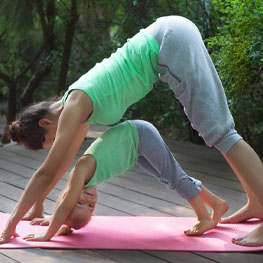
How can you tell if your child needs relaxation? If your offspring’s behavior is driving you nuts, it may be time to work on relaxation. Kids who are tightly wound up can be exhausting; they might chronically overreact, demand constant attention or seem like they are annoying you on purpose. Really, they might be overwhelmed and may need help to get grounded.
Why focus on relaxation instead of behavior management?
Rewards and consequences are important in parenting. However, they work best when a child is in a calm state educators call ‘available for learning.’ Anxiety impairs the brain, activating the fight-or-flight functions and inhibiting the areas that communicate, make plans and solve problems. Stress also hampers impulse-control, making tense kids act defiant or start whining before they can consider the consequences.
Building up your child’s ‘relaxation muscle’ will help them respond to the world more effectively. They will think more clearly, make more positive choices and grow more confident and resilient. Further, when you switch your focus from their failures to their well-being, your relationship with your child will become more secure and productive.
Teaching relaxation will turn things around with your child now, and equip them to face stress wisely for the rest of their life. It will soften your daily battles, and ease your parenting stress.
How do you teach a child to relax?
It’s easy. Just start providing soothing activities every day. Help your youngster tune in to the way their body feels while they play. With regular practice, your child will begin to recognize and cultivate feelings of calm. Their chronic stress will begin to fade, and they will feel and function better.
Start playing with the seven soothing stimuli listed here. Let your child experiment and decide how long to play. Notice what works for them. Week by week, watch for a shift in their behavior: more smiles, yeses and ‘I can’ attitude. Tell them how much you enjoy these relaxing moments with them, and compliment them when they show calm in other situations. Don’t forget to pat your own back for creating and maintaining this beneficial space in your busy life.
1. Physical exertion:
Biking, hiking, jogging or tag.
Climbing, wrestling or tug of war.
Pulling a loaded wagon, sled or blanket.
Piggyback rides or wheelbarrow races.
Bouncing on a trampoline or hoppity ball.
2. Mindful movement:
Yoga, dance and martial arts.
Equipment that swings, spins or rocks.
Fast and Slow Game: Sprint on the spot for 10 seconds, then lie still for 10. Repeat three times. Notice the changes in your breath and body.
Progressive Muscle Relaxation: Tense your feet tightly for a slow count of 10, and then relax for 10. Notice the difference in sensations such as heaviness, heat, tingling, etc. Continue with legs, buttocks, stomach, shoulders, arms, hands, neck and face.
3. Breath awareness:
Blow bubbles or dandelion fuzz and watch them float away.
Blow through a straw to spread puddles of paint.
Blow on each other’s skin or hair.
Lie on your back with a toy on your belly, and give it a gentle ride up and down with deep breaths.
Take turns listening to your partner’s chest while they breathe deeply.
4. Water:
Fill a sink or a tray with water and add bubbles, toys, food coloring, etc.
Run through the sprinkler; feel the contrast of the hot sun and the cool water.
Go swimming; paddle vigorously and float serenely.
Soak in a hot tub, bath or splash pool.
Have a water fight or cool off with a misting bottle.
5. Sensory play:
Bury hands in a dry bin filled with sand, rice or beans.
Drive toys through a wet plateful of shaving cream, finger paint or jello.
Practice copying each other’s rhythms with clapping, stomping and instruments.
Play with pinwheels, sand or water timers or a calming glitter bottle.
Close your eyes and guess objects by their feel, smell, sound or taste.
6. Music:
Burn off excess energy with fast, upbeat music.
Cultivate calm with lullabies, classical, folk or reggae.
Play music in the background during playtime or chores.
Fall asleep to a mellow playlist.
Dance, sing, play along or have a parade.
Listen quietly while cuddling or hiding out in a fort.
7. Nature:
Romp around the playground.
Create a bug safari or outdoor obstacle course.
Make mud pies or a Fairy Garden.
Eat outside.
Skate, sled or build a snowman.
Gather tidbits for crafts or sketch interesting specimens.
Go camping or tent in the back yard.
Now go ahead and start teaching ‘Relaxation 101’ to your child. It is going to be fun! Gentler moods and powerful life skills are on the horizon for your family.
Six relaxing resources to enjoy with your kids
1. KidsRelaxation - A blog with tons of free activities, videos and links; kidsrelaxation.com
2. Complete Muscle Relaxation Fun for Kids - A guided relaxation video; youtube.com/watch?v=aaTDNYjk-Gw
3. 123Kids Yoga Full Class - An online instructional video; youtube.com/watch?v=-qBOdAde-mg
4. Gaiam Yogakids 3 - Silly to Calm DVD; gaia.com/video/yoga-kids-3-silly-calm
5. The ABCs of Yoga for Kids by Author Teresa Anne Power - Book and cards; abcyogaforkids.com
6. Quiet Time by Raffi - Music CD; amazon.ca
Laurie loves doing yoga videos with her high-intensity preschooler. She thanks Bob Marley’s music for saving her when she feels like putting the kids on Craigslist.
Calgary’s Child Magazine © 2024 Calgary’s Child